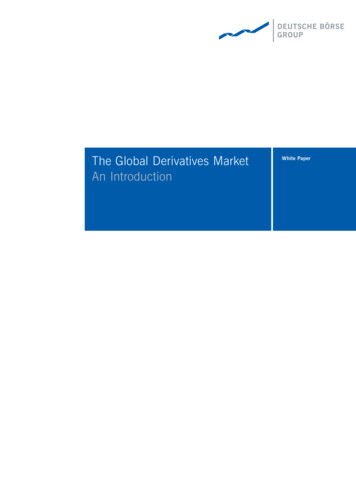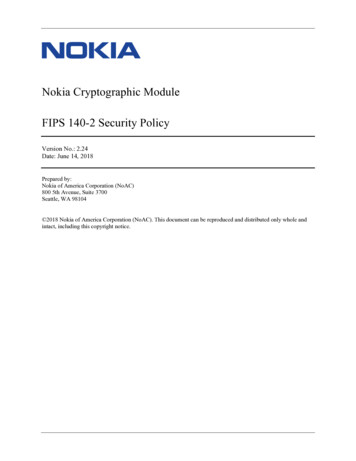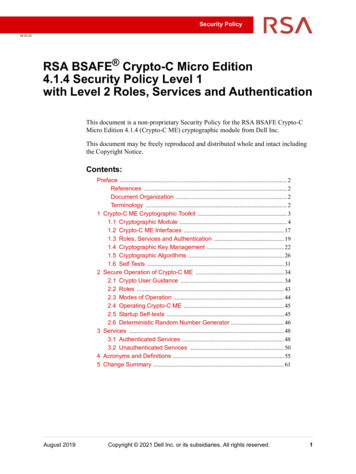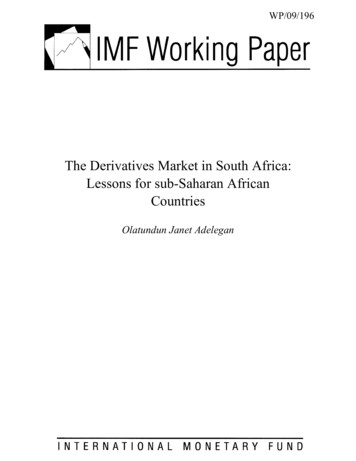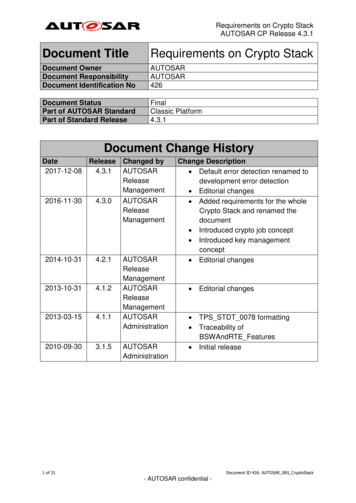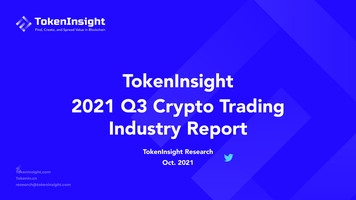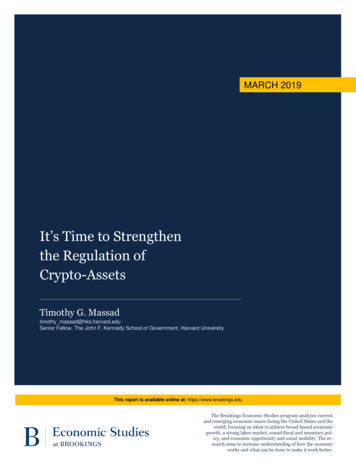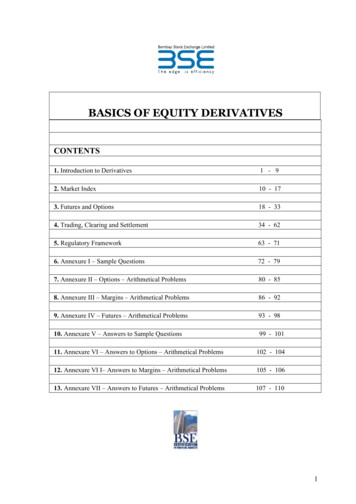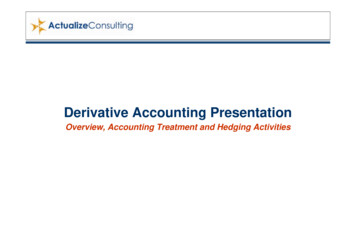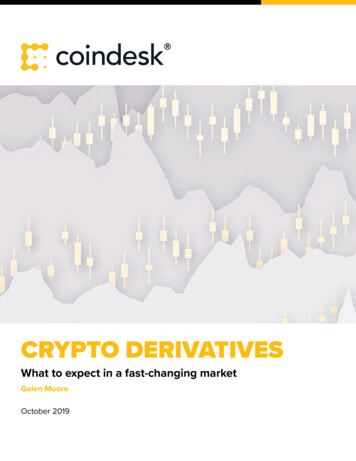
Transcription
CRYPTO DERIVATIVESWhat to expect in a fast-changing marketGalen MooreOctober 2019
CONTENTSIntroduction.3Crypto asset derivatives’ potential benefits to investors.4Custody. 4Supply. 4Risk management. 4How are crypto derivatives different?.5Unknown fundamentals. 5Controlled supply . 5Unnatural hedges. 5The Wild East. 6Perpetual swaps. 624/7 markets. 6What’s available today.7Product overview. 7Exchange-traded products. 7Custom derivatives OTC. 7Futures and forwards. 7Perpetual swaps. 7The regulated newcomers.9Forthcoming offerings. 12Regulatory challenges.12Conclusion. 13Version 1.1
INTRODUCTIONThe year 2019 has been a busy one for crypto derivatives. Some existing exchanges haveposted record volumes. Over-the-counter (OTC) trading desks are announcing new customofferings and nearly half a dozen startup exchanges are planning U.S. launches with exchangetraded derivatives that put a twist on existing derivatives markets, both in crypto and in otherasset categories.Cryptocurrency purists may see crypto derivatives as a kind of contradiction in terms.Bitcoin is designed to be transferred peer to peer, without intermediaries like the brokers,exchanges and clearinghouses that characterize derivatives markets. Its supply is designedto be constrained absolutely, to 21 million units; derivatives enable trading volume beyondthe supply of an underlying asset. However, crypto assets may be well suited to derivatives.This paper will go over some of the ways in which that is so.Institutional investors may wonder whether it’s responsible to dabble in an asset as volatileas bitcoin, where markets are manipulable, fundamentals are lacking and regulation may beimmature. If the underlying asset is too dangerous to hold, how much shakier is a leveredderivative built atop it? This paper will answer questions about what makes crypto assetsdifferent from other categories of derivatives.Anyone who gets over these hurdles will be wondering how to approach crypto derivativesmarkets. This paper will go over what’s available today, both in regulated and lightly regulated markets. We’ll also cover the context in which today’s offerings sprung up, and intowhich new derivatives products are emerging. For more papers like this one, introducingcrypto assets to professional investors, please visit coindesk.com/intro-to-crypto-investment.You can email the author at galen@coindesk.com.3 CRYPTO DERIVATIVES: What to expect in a fast-changing market
CRYPTO ASSET DERIVATIVES’ POTENTIALBENEFITS TO INVESTORSGrowth in derivatives can be understood as a byproduct of growing institutional interest incrypto assets. To understand why, let’s focus on bitcoin. There are three factors that makederivatives especially attractive to investors in bitcoin.CustodyBitcoin is a digital bearer instrument. This quality is at the heart of its innovation: bitcoin is thefirst all-digital asset, where ownership can be proved without recourse to a central authority.There is no title and no recourse in the event of loss or theft. The operational requirementsof safe crypto asset custody are new, posing questions that for asset managers can becomeobstacles.1 Derivatives, to the extent they offer exposure to cryptocurrencies without theneed to custody the asset, offer a potential way around these operational obstacles.SupplyUnlike almost any other asset in the world, bitcoin’s supply is strictly limited. It draws its valuefrom a “deflationary monetary policy” that sets a supply cap programmatically at 21 millionBTC. Bitcoin can be fractionalized out to eight decimal places, or 100 millionth of a bitcoin.This provides some assurance against any concern that bitcoin might become too valuableto trade, but it doesn’t address a possible scenario in which trading volume increases, butthe price remains stagnant. To date, bitcoin’s price and trading volume are inconsistentlycorrelated. (See Figure 1.) Derivatives expand the capacity of bitcoin markets, allowing valueto flow into synthetic assets built upon the underlying 21 million coins.Figure 1: Bitcoin’s price won’t necessarily keep pace with volume90-day correlation, bitcoin price vs. ce: coinmetrics.io, retrieved Sept. 11, 2019. Volume data is Coinmetrics’ adjusted daily native units transferred metric.Risk managementTaking a long position in bitcoin is a speculative bet on an entirely new category of assets.Some day, bitcoin may become a “safe haven” investment, but today it looks more like arisk-on asset.2 Derivatives provide opportunities to hedge that risk and, on the other side ofthe risk spectrum, opportunities to double down on it via leveraged trade.1 Galen Moore, “Custody: Crypto Assets’ Unique Challenge and Opportunity,” CoinDesk Research, August 20192 Galen Moore, “Is Bitcoin a Safe Haven?” CoinDesk Research, August 20194 CRYPTO DERIVATIVES: What to expect in a fast-changing market10/16/1710/16/18
HOW ARE CRYPTO DERIVATIVES DIFFERENT?Consistency is part of what makes derivatives attractive: for example, futures contractsbacked by one kind of commodity may trade much like futures in other markets, though theunderlying commodities behave very differently. This makes derivatives a useful onramp forinvestors who are unfamiliar with crypto, a new asset category.However, there are some differences between crypto derivatives and other categories ofderivatives. Here is a brief primer on features of crypto derivatives that may be unfamiliar totraders used to established derivatives markets.Unknown fundamentalsCrypto derivatives are different because the fundamentals of the underlying asset are notunderstood. Investors who trade crypto derivatives have probably never before seen a derivatives market that operates without an understanding of underlying fundamentals. Potentialanalytical methods are worth studying, but so far the prices of bitcoin and other crypto assetsappear to move more on momentum than on fundamentals. For example, a trader new tocommodities futures can make a quick study of the supply and demand dynamics driving theprice of the underlying. No such entry-level analysis exists in bitcoin or other crypto assets,where fundamentals, if they have been established, are yet to be widely accepted.Controlled supplyIn commodities derivatives markets, investors analyze fluctuations in supply and demand ofthe underlying commodity. Any number of factors influence the annual supply of wheat, goldor oil. Bitcoin’s supply schedule is controlled: it is programmed to hew to a fixed schedule,whether one computer is mining it or 100,000.3Unnatural hedgesCrypto assets don’t necessarily have the same “natural hedgers” as commodities do. Forexample, gold miners use futures to lock in prices that will cover their expected costs. Bitcoinalso has “miners,” who run the computing infrastructure that powers its network. However,the bitcoin mining business is different from commodities production. For one thing, the priceof bitcoin is more volatile than any known commodity.4The operating environment in the nascent crypto-mining industry is also tremendously volatile – an order of magnitude more so than traditional mining. The chart on the following pageshows how much “hash rate,” or computing power, bitcoin miners are putting into the network,which is a proxy for their operating expenditure, and compares that to growth in mining op-ex.Using some of the most efficient mining equipment advertised today,5 2018’s average hashrate would equate to about 463 kw/h of electricity consumed each second.For the first time, a digital commodity is under production. Its producers, the miners, areamong those using derivatives to hedge against declines in price, but their operating activitydoes not follow established patterns in physical commodities, and therefore their hedgingbehavior in derivatives markets may not, either.3 “Controlled Supply,” Bitcoin Wiki, retrieved Sept. 17, 20194 Galen Moore and Noelle Acheson, “Crypto in Context: The Social and Technical Underpinnings of an EmergingAsset Category,” CoinDesk Research, July 20195 Daniel Palmer, “Bitmain Ramps up Power and Efficiency With New Bitcoin Mining Machine,” CoinDesk, Septem9, 2019Addberhedgeclause TK TK TK5 CRYPTO DERIVATIVES: What to expect in a fast-changing market
Figure 2: “Mining” ain’t what it used to beGlobal mining industry op-ex and bitcoin mining hash rate, 2016-2018 44436.79 470 3717.101.732016Avg. bitcoin mining hash rate (exahashes)20172018Global mining aggregate operating spend (US billions)Source: BTC.com (retrieved Sept. 16, 2019) and PwC, “Mine 2018: Tempting Times”The Wild EastThe largest lit exchanges operating today in crypto derivatives are based in Asia and arelightly regulated compared to competitors regulated by U.S. or E.U. governments. Factorsthat set them apart from regulated operators include direct access to the exchange for bothretail and institutional investors, and the availability of leverage up to 100X.Perpetual swapsOne of the most popular products in crypto asset derivatives is the perpetual swap, reportedly invented by BitMEX, a lightly regulated crypto derivatives exchange based in Asia.6 If notentirely unique to crypto assets, the popularity of these perpetual swaps is certainly not replicated in any other asset class. Unlike futures, perpetual swaps do not have a closing date.They settle to an index periodically (on BitMEX settlement occurs every eight hours), lettingtraders maintain their positions without rolling them over.24/7 marketsUnlike most derivatives markets, crypto derivatives indexes pull data from markets that areopen 24 hours a day, seven days a week.6 Paul Amery, “The Wild World of Crypto Derivatives,” New Money Review, June 26, 20196 CRYPTO DERIVATIVES: What to expect in a fast-changing market
WHAT’S AVAILABLE TODAYAs discussed above, crypto derivatives offer a variety of investment possibilities: a morefamiliar way to custody a buy-and-hold strategy; hedges against long positions in a volatileasset category; leverage to increase exposure in a supply-constrained market. This sectiondeals with the markets and products that exist today to answer those needs.Product overviewHere is a brief overview of the categories of crypto asset derivatives that are available toinvestors, at this writing.Exchange-traded productsCrypto asset derivatives are compelling in part because of their ability to provide exposureto bitcoin and other crypto assets via regulated markets and familiar financial instruments.Several offerings today may not be “derivatives” per se, but answer that demand. In Europe,bitcoin-backed exchange-traded notes (ETNs) have been available since at least 2015.7 Sofar, efforts in the U.S. to replace such synthetic derivatives with an Exchange-Traded Fundhave not met with regulatory approval. In the meantime, Grayscale Investments’ Bitcoin Trust(GBTC), another synthetic derivative that tracks the price of bitcoin, is open to accreditedinvestors and trades on OTC markets.Custom derivatives OTCOTC trading represents an extraordinarily large share of crypto markets activity--as muchas 60 to 65 percent, by some estimates.8 OTC desks, some with minimum trades in thesix figures, offer a number of bespoke derivatives products to clients, potentially includingoptions, swaps, forwards and, where legal, contracts for difference.Futures and forwardsNotional volume in standardized futures and forwards contracts is dominated by a handful oflightly regulated exchanges, mostly based in Asia. In the U.S., regulated bitcoin futures areavailable through the CME, and a handful of startups are preparing to offer alternative bitcoinfutures under CFTC regulations.Perpetual swapsReportedly invented by BitMEX, an Asia-based derivatives exchange, perpetual swaps actlike futures, but do not have a closing date; instead, longs and shorts settle to the index periodically, in cash.7 Yessi Bello Perez, “Sweden’s Nasdaq Exchange Approves Bitcoin-based ETN,” CoinDesk, April 29, 20198 “Institutional Crypto-Trading Platforms: Blockchain Meets Block Trade,” Aite Group, May 21, 20197 CRYPTO DERIVATIVES: What to expect in a fast-changing market
Figure 3: The largest bitcoin futures exchangesBTC futures and perpetuals, 30-day average reported volume (US billions), Aug. 20–Sept. t0.30CME0.22Binance0.21CryptoFacilitiesab OKEx offers futures contracts with up to 20X leverage. It is headquartered inHong Kong and domiciled in Malta.2.15HuobiFTX BitMEX offers perpetual swaps and futures contracts with up to 100Xleverage. It is headquartered in Hong Kong and domiciled in the Seychelles.0.110.06 HuobiDM offers futures contracts with up to 20X leverage. It is headquartered and domiciled in Singapore. BitFlyer offers up to 5X leverage. It is headquartered and domiciled in Japan. CoinFlex offers futures contracts with up to 20X leverage. It is headquarteredin Hong Kong and domiciled in the Seychelles. CME Group offers futures contracts with up to 2.7X leverage.a It is headquartered and domiciled in the U.S. Deribit offers perpetual contracts, futures contracts and “European-style”options, with up to 100X leverage. It is headquartered and domiciled in theNetherlands, but not subject to Dutch financial regulations.b Crypto Facilities (now Kraken Futures) offers futures contracts with up to 50Xleverage. It is headquartered and domiciled in the U.K.“CME Bitcoin Futures FAQ,” retrieved August 12, 2019.Alastair Marsh, “Cryptocurrency Exchange Introduces Block Trading for Derivatives,” Bloomberg, August 22, 2019Source: Skew.comVolume in crypto derivatives is apparently dominated by BitMEX, Huobi and OKEx, all lightlyregulated, Asia-based exchanges. Volumes reported by Huobi and OKEx have been repeatedly called into question,9 but there is no doubt that all three of these exchanges haveattracted significant retail investor activity and have proven useful to liquidity providers andothers who need nimble hedging strategies.However, their regulatory status raises potential counterparty risks. For example, do theexchanges trade on their own account? How much of their revenue comes from forced liquidations? Unlike regulated U.S. or European entities, these exchanges are not clearinghouses,instead using a mixture of apportioned winnings and insurance funds to ensure that winnersget paid, which raises questions about certainty of settlement and may make them unsuitablefor inclusion in a broader portfolio strategy. They are unlikely to ever prove viable options forasset managers investing client funds.9 Teddy Fusaro and Matt Hougan, “Presentation to the U.S. Securities and Exchange Commission,” BitWise AssetManagement, September 17, 20198 CRYPTO DERIVATIVES: What to expect in a fast-changing market
THE REGULATED NEWCOMERSAs in other areas of crypto, regulated derivatives exchanges are followers, coming behindlightly regulated or unregulated venues. Institutional products have been preceded by offerings marketed to retail investors. In December 2017, two large derivatives exchanges in theU.S., the CME and Cboe, launched bitcoin futures markets approved by the CFTC. Their movewas closely watched as an introduction of legitimacy and an on-ramp for institutions into amarket that had grown up with minimal regulation.Uptake was anemic at first.10 The near-simultaneous roll-out of derivatives on CME and on itsrival, Cboe, coincided with bitcoin’s all-time high and the beginning of a bear market that sawbitcoin’s price fall 83 percent, according to the CoinDesk Bitcoin Price Index.Figure 4: Growing Interest in Bitcoin FuturesCME Bitcoin Futures open intererst (contracts) versus : BloombergIn May of this year, as bitcoin started to pull out of the 2018 market slump, average tradingvolumes in CME’s bitcoin futures hit new highs, reaching 13,600 contracts, or 515 million(68,000 BTC) in notional value.11 CME may have benefited when Cboe shut down a competingproduct in Q2, but its volume figures show a growing market for bitcoin futures.In the months leading up to CME’s May breakout, OTC desks were quietly serving cryptoclients with derivatives through the bearish “crypto winter.” Private options trading emergedin late summer 2018, fueled by a supply-side need for cash among firms that were naturally long bitcoin and other crypto assets.12 Over-the-counter (OTC) desks at Akuna Capitalin Chicago and QCP Capital in Singapore led the emerging trade, followed later by GalaxyDigital of New York.10 Gertrude Chavez-Dreyfuss, et al., “Exchange Giant CME’s Bitcoin Futures Get Tepid Take-up in Debut,” Reuters,December 17, 201711 Sebastian Sinclair, “May Was Best Month for CME Bitcoin Futures Volume Since 2017,” CoinDesk, June 7, 201912 Alastair Marsh “Crypto Survivors Find a Rare Lifeline,” Bloomberg, February 12, 20199 CRYPTO DERIVATIVES: What to expect in a fast-changing market
Figure 5: A timeline of derivatives offeringsSeptember 2019CME announces plan to offer options on itsbitcoin futures contractsAugust, 2019 Multiple startups get U.S. approval for physicallysettled bitcoin futures Deribit rolls out block trading in crypto derivativesDerivatives activity isheating up in 2019July, 2019UK moves to ban crypto derivativesfor retail investorsJune, 2019Galaxy Digital offers options contractsMarch, 2019Cboe winds down futures marketFebruary, 2019 Kraken acquires UK-registered futures market Offshore Coinflex exchange announcesphysically settled futuresJanuary, 2019B2C2 gets UK approvalfor crypto asset CFDsAugust, 2018Private options trade emergeson crypto OTC desksJune, 2014Huobi launches BitVC,HongKong-based derivatives marketJuly, 2017LedgerX gets US approval foroptions and swaps trading20152016December, 2017CME and Cboe launch bitcoin futures201720182019Source: Compiled by CoinDeskSidebar: Why did Cboe fail?When regulated futures first came to bitcoin trading in the U.S., in the fourth quarter of 2017, therewere two entrants: CME Group and Cboe Global Markets. In March, Cboe announced it would list nonew bitcoin futures contracts.a It’s tempting to view Cboe’s capitulation as a signal of weak demandfor bitcoin futures. The truth is traders preferred CME’s product. The outcome of a cash-settled futureis manipulable in a thinly traded underlying asset like bitcoin, where large buy or sell orders couldmove the price enough to alter the outcome of a futures trade. Cboe’s product relied on pricingdata from just one source: the Gemini Auction, conducted daily by Gemini Trust Company, a New York-based digital assetexchange and custodian. CME, on the other hand, aggregates data from multiple spot exchanges.ba Marc Hochstein, “Cboe Exchange Puts Brakes on Bitcoin Futures Listing,” CoinDesk, March 14, 2019b “Bitcoin Pricing Product Frequently Asked Questions,” CME Group, retrieved August 13 201910 CRYPTO DERIVATIVES: What to expect in a fast-changing market
While U.S. newcomers have moved through the regulatory process, new offerings in the U.K.have come to market faster. In February 2019, Kraken, a U.S.-based spot exchange, acquiredCrypto Facilities, a U.K. firm, in order to offer a futures market regulated by the BritishFinancial Conduct Authority (FCA). Crypto Facilities operates a regulated futures exchange,and provides bitcoin reference rates to CME Group.A month earlier, B2C2 OTC, a London-based OTC desk, got FCA approval to offer its clientscontracts for difference (CFDs), a type of derivative that allows traders to take long and shortpositions on margin with no expiration date. CFDs are a non-standardized product, providedby OTC desks, and are not yet permitted under U.S. financial regulations.Questions about market surveillance dog efforts to create new derivatives offerings in cryptoassets.13 With standards such as tick size not yet established in a market fragmented acrossdozens of exchanges, and the potential for new patterns and anomalies indicative of manipulation, regulators face challenges in defining the transparency required in markets thatprovide index data.1413 Laura Shin, “All Things Crypto Regulation With Jake Chervinsky,” Audio blog post, Unchained, August 6, 201914 Noelle Acheson, “Who’s Watching? Crypto Market Surveillance and Why It Matters,” Audio webinar, CoinDesk,June 26, 201911 CRYPTO DERIVATIVES: What to expect in a fast-changing market
FORTHCOMING OFFERINGSNo fewer than five startups have been preparing to come to market with a CFTCregulated product that all have a feature in common: physically settled bitcoin futures.One firm outside U.S. jurisdiction, CoinFlex (Seychelles), already offers physical settlement.15 Physically settled futures may provide an antidote to alleged price manipulationin bitcoin spot markets, by eliminating the ability to engineer the outcome of a contractby bidding the index price up or down.CoinFlex competes against unregulated exchanges like BitMEX. If any of the companiesbelow are successful in delivering a physically settled futures contract, it will be the first to doso under U.S. financial regulation. At this writing, it remains to be seen whether investors willprefer physical settlement in crypto assets. Bakkt, a subsidiary of NYSE parent Intercontinental Exchange (ICE), is preparing inSeptember 2019 to roll out a derivatives trading venue that will include physically settledbitcoin futures, including a daily contract that settles in T 2, which presents the possibilityof a derivative that could be used either as a spot equivalent, or, taking advantage of itsT 2 settlement to build a forward curve and continue to roll the contracts, as an instrumentnot unlike the BitMEX perpetual swap.ErisX, an indirect subsidiary of Eris Exchange, which has offered trading in interest rateswap futures, is preparing to offer a market for physically settled bitcoin futures.LedgerX offers a regulated venue for trading bitcoin swaps and options; it is preparing tomatch orders in physically settled bitcoin futures, pending regulatory approval.Seed CX is preparing to offer trading in physically settled bitcoin margin swaps. Tassat(fka TrueDigital) is preparing to offer trading in physically settled bitcoin swaps andother derivatives.Regulatory challengesAt this writing, crypto futures exchange operators face challenges getting CFTC approval forphysically settled bitcoin futures. The regulatory challenge for these would-be crypto futuresexchanges is threefold: One,futures, which are standardized products that trade openly on exchanges, are moretightly regulated than swaps, their bespoke and over-the-counter cousins. Two,physical settlement requires a “warehouse” for the digital asset. Certifying the security of this warehouse is a novel exercise for the CFTC and has been an obstacle for somewould-be providers.16 Three,retail investors: some exchanges propose to offer products to retail investors,which is a departure from the norm in most derivatives markets.15 Deribit, a derivatives market based in the Netherlands, settles contracts in cash, paid in bitcoin. It does not offerphysically settled contracts, contrary to an earlier version of this paper.16 John McCrank, “Bakkt Says Bitcoin Futures Testing to Begin in July,” Reuters, June 13, 201912 CRYPTO DERIVATIVES: What to expect in a fast-changing market
CONCLUSIONCrypto assets represent a new form of investment and ownership. For the first time, there isa digital “real asset,” in which valuation does not depend on cash flows, and in which title isnot administered through any intermediary. How these innovative qualities will be useful isnot yet fully understood. What is known is that they have presented opportunities for returnsand volatility, uncorrelated with other asset categories.As a new form of investment, crypto assets also present problems for those seeking exposure to this opportunity. The operational aspects of managing crypto asset investments mayappear different from anything investors are used to. Derivatives may hold solutions to someof those operational challenges. The emergence of regulated derivatives markets—the introduction of new products and venues, and the growth of existing ones—is part of the maturation of the crypto asset category.It remains to be seen if, through derivatives, crypto assets will impact the broader financialsystem in a similarly positive way. Crypto assets emerged in isolation from global finance, asan alternative to established systems. As adoption increases, this alternate financial systemmay become more integrated with established structures. Derivatives clearinghouses aresome of the arenas in which this integration is happening today.Contagion in the 2008 financial crisis resulted from money managers selling to raise liquidityto satisfy margin calls on credit default swaps and other OTC derivatives.17 If crypto assetslike bitcoin become tied into global financial markets through derivatives, a similar kind ofcontagion could spread from a crypto crash.Bitcoin was founded as a response to boom-bust cycles in the global economy.18 If it growsto the potential that some investors believe it can reach,19 how ironic to think that it couldcontribute to the causes of another economic crisis.Special thanks for insights and data to Max Boonen of B2C2, Clint Cox of Crypto Futura Fund,Emmanuel Goh and Tim Noat of Skew, Dan Matuszewski, Rumi Morales of Outlier Ventures,Timo Schlaefer of Kraken Futures, Yinfeng Shao of Reciprocity Trading, and Brian Tehako ofHehmeyer Trading & Investments.17 Michael Greenberger, “The Role of Derivatives in the Financial Crisis,” U.S. Senate Financial Crisis Inquiry Commission testimony, June 10, 201018 “Genesis Block,” Bitcoin Wiki, retrieved September 17, 201919 Helen Partz, “ 250K Price Prediction Is Now ‘Conservative,’ Says Tim Draper,” CoinTelegraph,
CRYPTO ASSET DERIVATIVES' POTENTIAL BENEFITS TO INVESTORS Growth in derivatives can be understood as a byproduct of growing institutional interest in crypto assets. To understand why, let's focus on bitcoin. There are three factors that make derivatives especially attractive to investors in bitcoin. Custody Bitcoin is a digital bearer .
